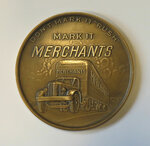

Just about everything a person owns comes from somewhere. And those items were likely shipped by truck or rail. For many years, the Midway area was a hub for freight shipping.
Rail was the Midway’s first mode to move freight. The legendary James J. Hill led efforts to start the Minnesota Transfer Railway Company, seeing the need for a centrally located terminal and freight transfer location. The company was incorporated in 1883, to serve what were then nine major railroads in St. Paul and Minneapolis.
According to the Minnesota Historical Society, Minnesota Transfer was authorized to operate railway lines in Ramsey, Hennepin and Anoka counties, and to provide terminal and transfer service to its nine railroad owner lines.
Its largest rail yard was in West Midway. About 20 million cars passed through its yards between 1910 and 1916. In 1955, the company operated 103 miles of yard tracks and sidings, as well as terminal facilities, in St. Paul, Minneapolis, New Brighton and Fridley.
Railroads could not handle freight alone. In the late 19th century, several much smaller drayage companies operated in Midway. One of those was operated by the Murphy family, which opened its business in 1904 with two horses and a wagon. These small firms played a big role in ensuring that goods moved from warehouse and rail freight depots to businesses and industries.
Motor vehicles replaced horses and soon, the motor freight industry would rise. One factor was the use of the nation’s railroads for military purposes in World War I. That shifted freight shipping to motor trucks.
That shift in shipping continued to evolve and Midway, with large open spaces, became a trucking hub. Marion Daniel Shutter’s book “History of Minneapolis, Gateway to the Northwest,” notes how inefficient it was for trucks to deliver a load and then return home empty. That led to the founding of the Minneapolis & St. Paul Truck Terminal Company in 1921. The company was a co-operative, and within two years had 90 trucks. A vast trucking district grew, and truck terminals began popping up in Midway. One large facility was near University and Prior avenues.
By the mid-1940s, Midway had more than 40 motor freight companies. The companies were of all size, some with only a few trucks and about 20 with fleets of big rigs ready to roll. Many were located near the Minnesota Transfer Railway hub.
Trucking boomed after World War II, and the Midway’s manufacturing industry was joined by many warehouses. It made more sense for businesses and industries to keep smaller supplies of goods on hand, when items could be easily shipped door to door.
During the summer of 1950, four new truck terminals – Mueller Transportation, Bruce Motor Freight, Ajax Transfer Company, and Northwest Freight Lines – made plans to locate in the Midway, joining Murphy Motor Freight, Merchants Motor Freight, Midnite Express, and the Wittee and Short companies. Some companies were able to expand and grow nationally.
One was Merchants. Memorabilia seekers can find large paper clips and brass paperweights with the slogan “Don’t mark it rush - mark it Merchants.”
Another company to note is Murphy Motor Freight Lines, which would evolve from its horse and wagon days to, at one point, become the largest trucking company based in Minnesota.
Trucking firm leaders were also community leaders. Edward L. Murphy, Jr., former Murphy president and CEO, is an example of that. At the time of his death in 2013, it was noted that he not only had served on national and state trucking association boards, he also served on numerous civic and community boards.
Trucking pushed along the need to develop and expand the freeway system. A June 2, 1954 Minneapolis Star article describes the construction of Highway 280. “A new state highway designed to channel heavy truck traffic into the Midway trucking area of the Twin Cities is under construction just east of the Minneapolis boundary with Lauderdale and St. Paul,” the article stated.
But that time was the beginning of the end. In the 1950s, more area trucking firms were moving to Roseville, which was described in one 1959 newspaper article as the “suburban Midway.” Roseville offered cheaper land and room to expand.
The heyday of Midway’s trucking industry was over.
Comments
No comments on this item Please log in to comment by clicking here